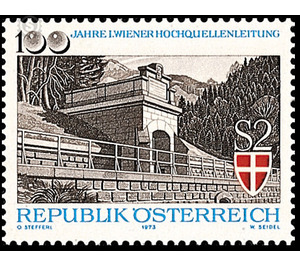100 years - Austria / II. Republic of Austria 1973 - 2 Shilling
Theme: Architecture
| Country | Austria / II. Republic of Austria |
| Issue Date | 1973 |
| Face Value | 2.00 |
| Color | brown |
| Printing Type | combination printing |
| Stamp Type | Commemorative |
| Item Type | Stamp |
| Chronological Issue Number | 772 |
| Chronological Chapter | OOS-OE2 |
| SID | 216485 |
| In 66 Wishlists | |
On 1 September 1873, the first Viennese high spring water pipeline, whose construction had caused quite a stir in the whole civilized world for that time, supplied fresh mountain water to Vienna. The water springs in several springs in the Rax and Schneeberg area, in the northeastern part of the northern Limestone Alps. The two first and most well-known sources are the Kaiserbrunnen and the Stixensteinerquelle. The Kaiserbrunnen, named after Kaiser Franz Joseph I, who donated the city of Vienna, is the most important source with 17,000 cubic meters of yield. The second most important source is the Stixensteiner spring, which rises in the east of the Schneeberg massif. The length of the first Vienna high spring water pipeline from the mountains to the federal capital is around 118 kilometers. The valleys and watercourses are overcome by 22 aqueducts and canal bridges, 29 tunnels lead the way to the aqueduct. The total gradient in the upper line between the Wasseralmquelle and the Kaiserbrunnen is about 279 meters, that of the water line between the Kaiserbrunnen and the water tank on the Vienna Rose Hill about 280 meters. In order to cover the water demand of Vienna, which has been steadily rising in a century, the seven springs from the Styrian side of the Schneeberg were fed into the high spring water pipeline. The brand image shows the Kaiserbrunnen in Höllental.


